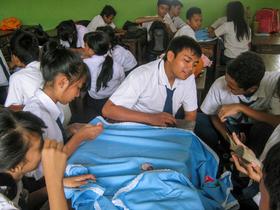For the 2025-26 school year, there is 1 public middle school serving 58 students in the neighborhood of Rosewood, Austin, TX.
The neighborhood of Rosewood, Austin, TX public middle schools have a diversity score of 0.42, which is less than the Texas public middle school average of 0.64.
Minority enrollment is 93% of the student body (majority Hispanic), which is more than the Texas public middle school average of 75% (majority Hispanic).
Best Public Middle Schools in the neighborhood of Rosewood, Austin, TX (2025-26)
School
(Math and Reading Proficiency)
(Math and Reading Proficiency)
Location
Quick Facts
Rank: #11.
Alternative Learning Center
Alternative School
(Math: <50% | Reading: <50% )
Rank:
Rank:
7/
Top 50%10
4900 Gonzales St
Austin, TX 78702
(512) 414-2554
Austin, TX 78702
(512) 414-2554
Gr: 6-12 | 97 students Student-teacher ratio: 5:1 Minority enrollment: 97%
Frequently Asked Questions
What are the top-ranked public middle schools in the neighborhood of Rosewood, Austin, TX?
The top-ranked public middle schools in the neighborhood of Rosewood, Austin, TX include Alternative Learning Center.
How many public middle schools are located in the neighborhood of Rosewood, Austin?
1 public middle schools are located in the neighborhood of Rosewood, Austin.
What is the racial composition of students in the neighborhood of Rosewood, Austin?
the neighborhood of Rosewood, Austin public middle schools minority enrollment is 93% of the student body (majority Hispanic), which is more than the Texas public middle schools average of 75% (majority Hispanic).
Recent Articles

Charter Schools vs Public Schools 2025: Key Differences & Trends
Explore updated 2025 insights comparing charter schools vs public schools, enrollment, academic outcomes, funding, and real-world examples for families and educators.

Are Public Schools Ready for the 21st Century? 2025 Update
Explore 2025 insights on whether public schools are ready for the 21st century, covering performance, technology, equity, funding, and future-ready learning.

Public School Open House & Enrollment Season Guide
A parent-focused guide to the public school open house and enrollment season, with expert questions, timelines, and decision tips.
